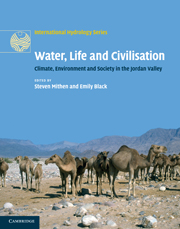Book contents
- Frontmatter
- Contents
- List of figures
- List of tables
- List of contributors
- Acknowledgements
- 1 Introduction: an interdisciplinary approach to Water, Life and Civilisation
- Part I Past, present and future climate
- Part II The palaeoenvironmental record
- Part III Hydrological studies of the Jordan Valley
- Part IV Human settlement, climate change, hydrology and water management
- Part V Palaeoeconomies and developing archaeological methodologies
- Part VI Society, economy and water today
- 24 Current water demands and future strategies under changing climatic conditions
- 25 Water reuse for irrigated agriculture in Jordan: soil sustainability, perceptions and management
- 26 Social equity issues and water supply under conditions of ‘water stress’: a study of low- and high-income households in Greater Amman, Jordan
- 27 The role of water and land management policies in contemporary socio-economic development in Wadi Faynan
- 28 Political discourses and public narratives on water supply issues in Amman, Jordan
- Part VII Conclusions
- Index
- Plate section
- References
26 - Social equity issues and water supply under conditions of ‘water stress’: a study of low- and high-income households in Greater Amman, Jordan
from Part VI - Society, economy and water today
Published online by Cambridge University Press: 26 April 2011
- Frontmatter
- Contents
- List of figures
- List of tables
- List of contributors
- Acknowledgements
- 1 Introduction: an interdisciplinary approach to Water, Life and Civilisation
- Part I Past, present and future climate
- Part II The palaeoenvironmental record
- Part III Hydrological studies of the Jordan Valley
- Part IV Human settlement, climate change, hydrology and water management
- Part V Palaeoeconomies and developing archaeological methodologies
- Part VI Society, economy and water today
- 24 Current water demands and future strategies under changing climatic conditions
- 25 Water reuse for irrigated agriculture in Jordan: soil sustainability, perceptions and management
- 26 Social equity issues and water supply under conditions of ‘water stress’: a study of low- and high-income households in Greater Amman, Jordan
- 27 The role of water and land management policies in contemporary socio-economic development in Wadi Faynan
- 28 Political discourses and public narratives on water supply issues in Amman, Jordan
- Part VII Conclusions
- Index
- Plate section
- References
Summary
ABSTRACT
One of the distinctive characteristics of the water supply regime of Greater Amman is that it has been based on a system of rationing since 1987 with households receiving water once a week for various durations. This reflects the fact that while Amman's recent growth has been phenomenal, Jordan is one of the 10 most water-scarce nations on earth. Amman is highly polarised socio-economically, and by means of household surveys conducted in both high- and low-income divisions of the city, the aim of this chapter has been to provide detailed empirical evidence concerning the storage and use of water, the strategies used by households to manage water, and overall satisfactions with water supply issues, looking specifically at issues of social equity. The analysis demonstrates the social costs of water rationing and consequent management to be high, as well as emphasising that issues of water quality are of central importance to all consumers.
WATER AND DEVELOPMENT AND THE CASE OF GREATER AMMAN, JORDAN
Access to adequate supplies of water is a universal component and indicator of human well-being and development. It plays a fundamental role in helping to resolve some of the manifold problems associated with poverty, disadvantage and exclusion. The United Nation's second World Water Development Report (WWAP (World Water Assessment Programme), 2006) serves to emphasise that human development is inextricably linked with issues of water availability and management, in terms of proximity, quantity and quality.
- Type
- Chapter
- Information
- Water, Life and CivilisationClimate, Environment and Society in the Jordan Valley, pp. 429 - 441Publisher: Cambridge University PressPrint publication year: 2011
References
- 1
- Cited by



